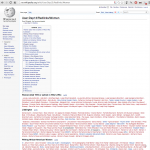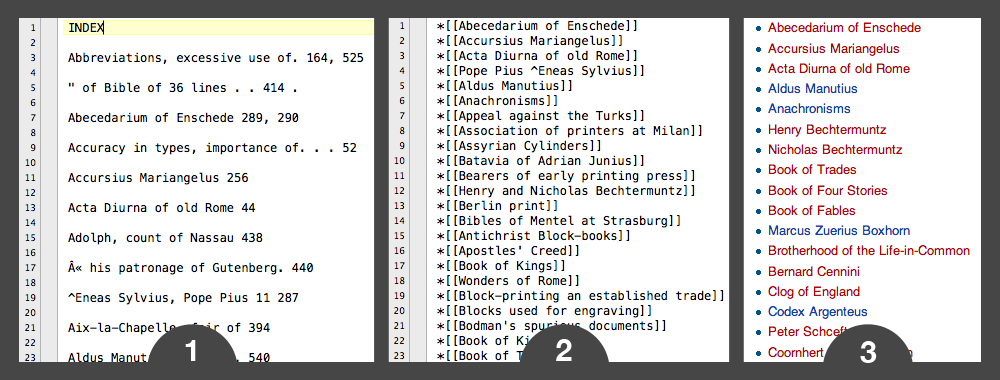This is an article I wrote for Lloyd Sealy Library’s Spring 2013 newsletter.

Guiding researchers to our resources from within Wikipedia articles
In March, a blog post by John Mark Ockerbloom circulated virally from librarian to librarian. The title, “From Wikipedia to Our Libraries,” describes typical online research:
The pattern of quick online information-finding using search engines and Wikipedia is well-known enough that it has its own acronym: GWR, for Google » Wikipedia » References. … It’s less important that our researchers start from our libraries’ websites than that they end up finding the knowledge resources our libraries make available to them. Looked at the right way, Wikipedia can be a big help in making online readers aware of their library’s offerings.
He goes on to explain the Library Resources template he made for use within a Wikipedia article that automagically points users to relevant resources in their local libraries and around the world. (Look at Flannery O’Conner’s page to see an example.)
As a regular Wikipedia user and editor myself, I strongly agree with Ockerbloom’s sentiment. Wikipedia, launched in 2001, is a robust beginning resource for many subjects, and you’d be hard-pressed to find anyone on a college campus who doesn’t use it with some frequency. In the site’s infancy, libraries tended to rail against Wikipedia, citing bad information and lack of expert editorship as its primary evils. But even as early as 2005, prominent sources like Nature began to conclude that Wikipedia had grown to be just as accurate as the print encyclopedias lining library walls (source). The difference, though, is that Wikipedia has 4.1 million articles in English (25 million total), more than any traditional encyclopedia can hope to have, and it’s used far more than any other beginning resource.
We can safely assume that Wikipedia is one inevitable resource for the college student, the curious passerby, and the expert researcher alike. Researchers at Project Information Literacy found that 82% of college students consult Wikipedia when working on a research project (source). The site is a starting point that can be a stepping stone toward deeper research. We information professionals have a responsibility to point interested readers to more exhaustive, credible resources—including our own. We can do this within Wikipedia in any given article by citing good related resources and unique materials held in our libraries and archives.
At John Jay, we are fortunate enough to have many rare and unique materials in our Special Collections, ranging from the records of the Mollen Commission (1990s investigation into NYPD corruption) to the personal papers of Richard Louis Dugdale (19th-century sociologist famous for studying the “Juke” family). For those collections whose finding aids or descriptions are completed, I have noted the availability of these materials in the relevant Wikipedia articles, including links to pages from the Library that give more information on the subjects. In this way, we can easily promote our materials and our scholarship on a high-visibility, high-traffic site.
For example, on William C. Dodge’s page, I have added (as of April 2013):
Dodge kept scrapbooks throughout his life documenting his career and personal interests. These scrapbooks are housed in the Special Collections of the Lloyd Sealy Library at John Jay College of Criminal Justice. Included in the Dodge Collection are materials related to his campaign and clippings from New York City newspapers that documented local crime at the time.[2]
The citation links to the Library’s finding aids page:
[2] “Manuscript Collection.” Lloyd Sealy Library Special Collections, John Jay College of Criminal Justice. Retrieved 5 March 2013.
This work is an ongoing process. Our hope is that more researchers will discover our extensive collections. We continue to add links to relevant Wikipedia pages as we review and receive more materials.
In addition, we’re proud to say that we are the first CUNY library to have its own Wikipedia page. Using material from Gerald Markowitz’s chronicle of John Jay College, Educating for Justice, and Prof. Nancy Egan’s rich history of the Library, the article describes our collections and services, in addition to our former and current facilities. Within hours, the page had already been improved by people unaffiliated with John Jay and by Wikipedia’s bots—both indicators of Wikipedia’s dedication to increasing quality.
In the interest of continuing to harness Wikipedia for the good of the research community, consider these questions:
To other CUNY librarians: Which special collections and unique materials do you have that you can link to from Wikipedia? Does your library need its own Wikipedia presence?
To other faculty members: What specialized knowledge do you have that you can contribute to Wikipedia?
To everyone: If you’re not a Wikipedia editor yet, you should be! If you’re a woman, I encourage you doubly: a 2011 Wikimedia Foundation survey found that only 9% of contributors identified as female, indicating a problematic perspective bias. Getting started as a Wikipedia editor is easy. Contributing can be as simple as correcting one punctuation error or as involved as creating a whole new article from scratch. Writing for Wikipedia may be challenging at first as you learn its etiquette and adopt the encyclopedic tone, but it’s surprisingly addictive—and rewarding.
Psst: this Friday, April 26, 2013, 1-3pm Eastern, join the world in the Global Women Wikipedia Write-In, “designed to encourage internet users to write entries about women from around the world into Wikipedia and to improve existing entries on these topics.” I’ve begun early by writing about Jane Grant!
___________________________________________________
References
 On Global Women Wikipedia Write-In Day, I was extremely impressed with user Dsp13’s lists of red links — lists of notable women that hadn’t yet been written about on Wikipedia. I used that page as a springboard to write about some notable women in American history, like the wonderful Agnes Surriage Frankland. Dsp13 took these lists of names from resources like Famous American Women: A Biographical Dictionary, signifying the notability of the listed names and giving editors a place to start their research.
On Global Women Wikipedia Write-In Day, I was extremely impressed with user Dsp13’s lists of red links — lists of notable women that hadn’t yet been written about on Wikipedia. I used that page as a springboard to write about some notable women in American history, like the wonderful Agnes Surriage Frankland. Dsp13 took these lists of names from resources like Famous American Women: A Biographical Dictionary, signifying the notability of the listed names and giving editors a place to start their research.


